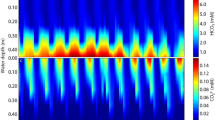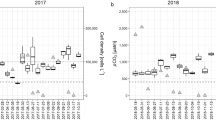Abstract
The organic carbon cycle of a shallow, tundra lake (mean depth 1.45 m) was followed for 5 weeks of the open water period by examining CO2 fluxes through benthic respiration and anaerobic decomposition, photosynthesis of benthic and phytoplankton communities and gas exchange at the air-water interface. Total photosynthesis (as consumption of carbon dioxide) was 37.5 mmole C m−2 d−1, 83% of which was benthic and macrophytic. By direct measurement benthic respiration exceeded benthic photosynthesis by 6.6 mmole C m−2 d−1. The lake lost 1.4 × 106 moles C in two weeks after ice melted by degassing C02, and 6.8 mmole C m−2 d−1 (1.5 × 106 moles) during the remainder of the open water period; 2.2 mmole C m2 d−1 of this was release Of CO2 stored in the sediments by cryoconcentration the previous winter. Anaerobic microbial decomposition was only 4% of the benthic aerobic respiration rate of 38 mmole C m−2 d−1. An annual budget estimate for the lake indicated that 50% of the carbon was produced by the benthic community, 20% by phytoplankton, and 30% was allochthonous material. The relative contribution of allochthonous input was in accordance with measurement of the δ15N of sedimented organic matter.
Similar content being viewed by others
References
Anema C, Hecky RE, Fee EJ, Nernberg D & Guildford S (1990a) Water chemistry of some lakes and channels in the Mackenzie Delta and on the Tuktoyaktuk Peninsula, N.W.T., 1985. Can. Data Rep. Fish. Aquat. Sci. 726: vii + 73 pp
Anema C, Hecky RE, Himmer S & Guildford S (1990b) Water chemistry of some lakes and channels in the Mackenzie Delta and on the Tuktoyaktuk Peninsula, N.W.T., 1986. Can. Data Rep. Fish. Aquat. Sci. 729: vi + 63 pp
Atkinson MJ & Smith SV (1983) C:N:P ratios of benthic marine plants. Limnol. Oceanogr. 28: 568–574
Bodaly RA, Reist JD, Rosenberg DM, McCarthy PJ & Hecky RE (1989) Fish and fisheries of the Mackenzie and Churchill River basins, northern Canada. In: Dodge DP (ed) Proc. International Large River Symp. (pp 128–144) Canadian Department of Fisheries and Oceans
Bond WA & Erickson RN (1982) Preliminary results of a fisheries study of two freshwater lake systems on the Tuktoyaktuk Peninsula, Northwest Territories Can. Department of Fisheries and Oceans. Can. Data Rep. Fish. Aquat. Sci. 348: vi + 62pp
Bond WA & Erickson RN (1985) Life history studies of anadromous coregonid fishes in two lake systems on the Tuktoyaktuk Peninsula, Northwest Territories. Department of Fisheries and Oceans. Can. Tech. Rep. Fish. Aquat. Sci. 1336: vii + 61pp
Bower PM, Kelly CA, Fee EJ, Shearer JA, DeClercq DR & Schindler DW (1987) Simultaneous measurement of primary production by whole-lake and bottle radiocarbon additions. Limnol. Oceanogr. 32: 299–312
Chang-Kue KTJ & Jessop EF (1992) Coregonid migration studies at Kukjuktuk Creek, a coastal drainage on the Tuktoyaktuk Peninsula, Northwest Territories. Department of Fisheries and Oceans. Can. Tech. Rep. Fish. Aquat. Sci. 1811: ix + 112pp
Crusius J & Wanninkhof RH (1990) A gas exchange-wind speed relationship measured on Lake 302N with SF6. Eos Trans. AGU 71: 1234
Fee EJ (1980) Important factors for estimating annual phytoplankton production in the Experimental Lakes Area. Can. J. Fish. Aquat. Sci. 37: 513–522
Fee EJ (1984) Freshwater Institute primary production model user's guide. Department of Fisheries and Oceans. Can. Tech. Rep. Fish. Aquat. Sci. 1328: v + 36 pp
Fee EJ, Hecky RE, Guildford SJ, Anema C, Mathew D & Hallard K (1988) Phytoplankton Primary Production and Related Limnological Data for Lakes and Channels in the Mackenzie Delta and Lakes on the Tuktoyaktuk Peninsula, NWT. Department of Fisheries and Oceans. Can. Tech. Rep. Fish. Aquat. Sci. 1614: v + 62 pp
Froelich PH, Klinkhammer GP, Bender ML, Luedtke NA, Heath GR, Cullen D, Dauphin P, Hammond D, Hartman B & Maynard V (1979) Early oxidation of organic matter in pelagic sediments of the eastern equatorial Atlantic: suboxic diagenesis. Geochim. Cosmochim. Acta 45: 1075–1090
Hargrave BT (1969) Epibenthic algal production and community respiration in the sediments of Marion Lake. J. Fish. Res. Board Can. 26: 2003–2036
Hesslein RH (1976) An in situ sampler for close interval porewater studies. Limnol. Oceanogr. 21: 912–914
Hesslein RH, Fox DE & Capel MJ (1989) Sulfur, carbon and nitrogen composition of fish from the Mackenzie River Delta Region and other Arctic drainages. Department of Fisheries and Oceans. Can. Data Rep. Fish. Aquat. Sci. 728: iv + 11 pp
Hesslein RH, Capel MJ, Fox DE & Hallard KA (1991) Stable isotopes of sulfur, carbon, and nitrogen as indicators of trophic level and fish migration in the lower Mackenzie River basin, Canada. Can. J. Fish. Aquat. Sci. 48: 2258–2265
Himmelblau DM (1964) Diffusion of dissolved gases in liquids. Chem. Rev. 64: 527–550
Hobbie JE (1964) Carbon 14 measurements of primary production in two Alaskan lakes. Int. Ver. theor. angew. Limnol. Verh. 15: 360–364
Hobbie JE (1980) Limnology of tundra ponds: Barrow, Alaska. Volume 3 of US/IBP Synthesis series, Dowden, Hutchinson and Ross, Inc., Stroudsburg, Pennsylvania
Jones JG & Simon BM (1980) Decomposition processes in the profundal region of Blelham Tarn and the Lund tubes. J. Ecol. 68: 493–512
Kalff J & HE Welch (1974) Phytoplankton production in Char Lake, a natural polar lake, and in Meretta Lake, a polluted polar lake, Cornwallis Island, Northwest Territories. J. Fish. Res. Board Can. 31: 621–636
Kelly CA & Rudd JWM (1984) Epilimnetic sulfate reduction and its relationship to lake acidification. Biogeochemistry J. 1: 63–77
Kelly CA, Rudd JWM, Cook RB & Schindler DW (1982) The potential importance of bacterial processes in regulating rate of lake acidification. Limnol. Oceanogr. 27: 868–882
Kelly CA, Rudd JWM, Furutani A & Schindler DW (1984) Effects of lake acidification on rates of organic matter decomposition in sediments. Limnol. Oceanogr. 29: 687–694
Kipphut GW (1978) An investigation of the rates of some physical processes in lake sediments. Ph.D. Thesis, Columbia University, New York, N.Y
Lawrence MJ, Lacho G & Davies S (1984) A survey of the coastal fishes of the southeastern Beaufort Sea. Department of Fisheries and Oceans. Can. Tech. Rep. Fish. Aquat. Sci. 1220: x + 178 pp
Li YJ & Gregory S (1974) Diffusion of ions in sea water and deep sea sediments. Geochim. Cosmochim. Acta 38: 703–714
Mackay J (1963) The Mackenzie Delta Area, N.W.T. Can, Dept. Mines and Technical Surveys, Geographical Branch. Memoir 8: 202 pp
Miller MC, Hater GR, Spatt P, Westlake P & Yeakel D (1986) Primary production and its control in Toolik Lake, Alaska. Archiv. f. Hydrobiol. Supp. 74: 97–131
Oglesby RT (1977) Relationships of fish yield to lake phytoplankton standing crop, production, and morphoedaphic factors. J. Fish. Res. Board Can. 34: 2271–2279
Pang PC & Nriagu JO (1977) Isotope variations of the nitrogen in Lake Superior. Geochim. Cosmochim. Acta 41: 811–814
Peters KE, Sweeney RE & Kaplan IR (1978) Correlation of carbon and nitrogen stable isotope ratios in sedimentary organic matter. Limnol. Oceanogr. 23: 598–604
Peterson BJ & Fry B (1987) Stable isotopes in ecosystem studies. Ann. Rev. Ecol. Syst. 18: 293–320
Ramlal PS, Anema C, Cummings E, Fee EJ, Guildford SJ, Hallard KA, Hecky RE, Hesslein RH, Himmer S, Kling H, Mathew D, Nernberg D & Schindler E (1991) Macrophyte and algal studies of some lakes in the Mackenzie Delta and on the Tuktoyaktuk Peninsula 1985–1986. Can. Data Rep. Fish. Aquat. Sci. 839: v + 87 pp
Rudd JWM, Kelly CA, St. Louis VH, Hesslein RH, Furutani A & Holoka MH (1986) Microbial consumption of nitric and sulfuric acids in acidified north temperate lakes. Limnol. Oceanogr. 31: 1267–1280
Schell DM (1983) Carbon-13 and Carbon-14 abundances in Alaskan aquatic organisms: delayed production from peat in Arctic food webs. Science 219: 1068–1071
Schindler DW, Welch HE, Kalff J, Brunskill GH & Kritsch N (1974) Physical and chemical limnology of Char Lake, Cornwallis Island (75 °N lat.). J. Fish. Res. Board Can. 31: 585–607
Sheath RG, Munawar M & Hellebust JA (1975) Phytoplankton biomass composition and primary productivity during the ice-free period in a tundra pond. In: Proc. Circumpolar Conf. Arctic Ecol. (pp III, 21–31) National Research Council, Ottawa
Stainton MP, Capel MJ & Armstrong FAJ (1977) The chemical analysis of freshwater, 2nd ed. Can. Fish. Mar. Serv. Misc. Spec. Publ. 25: 166 pp
Wanninkhof R , Ledwell JR & Broecker WAS (1985) Gas exchange-wind speed relation measured with sulfur hexafluoride on a lake. Science 227: 1224–1226
Welch HE (1974) Metabolic rates of arctic lakes. Limnol. Oceanogr. 19: 65–73
Welch HE & Bergmann MA (1985) Winter respiration of lakes at Saqvaqjuac, N.W.T. Can. J. Fish. Aquat. Sci. 42: 521–528
Welch HE & Kalff J (1974) Benthic photosynthesis and respiration in Char Lake. Can. J. Fish. Aquat. Sci. 31: 609–620
Welch HE, Legault JA & Kling HJ (1989) Phytoplankton, nutrients, and primary production in fertilized and natural lakes at Saqvaqjuac, N.W.T. Can. J. Fish. Aquat. Sci. 46: 90–107
Wetzel RG (1975) Limnology. W.B. Saunders Co., Philadelphia.
Wetzel RG, Rich PH, Miller MC & Allen HL (1972) Metabolism of dissolved and particulate detrital carbon in a temperate hard-water lake. Mem. Ist. Ital. Idrobiol. 29 (suppl.): 185–243
Whalen SC & Cornwell JC (1985) Nitrogen, phosphorus, and organic carbon cycling in an arctic lake. Can. J. Fish. Aquat. Sci. 42: 797–808
Author information
Authors and Affiliations
Rights and permissions
About this article
Cite this article
Ramlal, P.S., Hesslein, R.H., Hecky, R.E. et al. The organic carbon budget of a shallow arctic tundra lake on the Tuktoyaktuk Peninsula, N.W.T., Canada. Biogeochemistry 24, 145–172 (1994). https://doi.org/10.1007/BF00003270
Received:
Accepted:
Issue Date:
DOI: https://doi.org/10.1007/BF00003270




